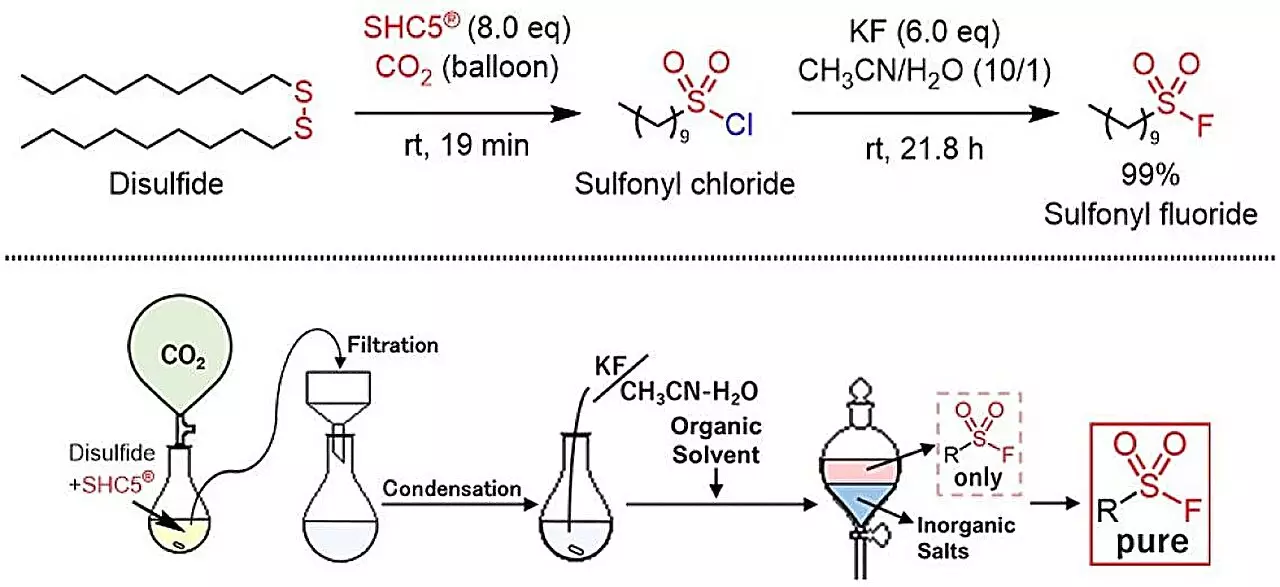Recent advancements in synthetic chemistry have presented a noteworthy innovation: the conversion of thiols and disulfides into sulfonyl fluorides through a novel reaction involving SHC5 and potassium fluoride (KF). This development speaks volumes about the evolution of click chemistry, a field celebrated for its efficiency, selectivity, and quick molecule integration. The method not only prioritizes chemical agility but also aligns closely with contemporary environmental standards, yielding only sodium chloride (NaCl) and potassium chloride (KCl) as by-products. The implications of this research, documented in ACS Sustainable Chemistry & Engineering, could set a new benchmark in both chemical and industrial synthesis methodologies.
Understanding the significance of sulfonyl fluorides is critical to appreciating this new methodology. As integral players in sulfur-fluorine exchange (SuFEx) click reactions, these compounds facilitate the linking of molecules, thus amplifying their utility across diverse applications—pharmaceuticals, materials science, and chemical biology, among others. Historically, the production of sulfonyl fluorides has been encumbered by the necessity of hazardous materials like SO2F2 gas or potassium hydrogen fluoride (KHF2), both of which pose significant safety and environmental concerns.
The pressing need for safe and green alternatives has spurred research efforts toward finding better synthesis methods. The current study addresses this very issue, revealing a streamlined process that employs readily available reactants—SHC5 and KF—to synthesize sulfonyl fluoride in a safe environment.
The synthesis technique introduced here not only showcases high chemical efficiency but also emphasizes environmental stewardship. Traditional methods have long been weighed down by the toxicity and handling difficulties associated with by-products. In contrast, this innovative approach generates non-toxic salts as waste, marking a significant stride toward sustainability in chemical synthesis. The researchers accentuate the simplicity of the synthetic protocol, which promises cost-effective scalability while minimizing safety risks.
Furthermore, the versatility of this method allows for the creation of a diverse array of sulfonyl fluorides, accommodating various structural groups—aromatic, aliphatic, and heterocyclic—thereby opening avenues for further exploration and development in multiple research domains.
Looking ahead, the potential for this new protocol to become the preferred method of sulfonyl fluoride synthesis in industrial and chemical labs is palpable. As the study’s authors, Masayuki Kirihara, Shinobu Takizawa, and Mohamed S. H. Salem, point out, there is an escalating imperative to conceive innovative organic synthetic pathways that yield useful compounds, particularly in light of the United Nations Sustainable Development Goals (SDGs). The growing anticipation of reaction processes that account for environmental consequences underscores the importance of this research.
The marriage of high efficiency and low environmental impact offered by the new methodology could herald a renaissance in synthetic chemistry. As researchers integrate these eco-friendly practices into their work, the scientific community may observe transformative changes in how compounds are synthesized, ultimately benefiting both industry and the environment.

